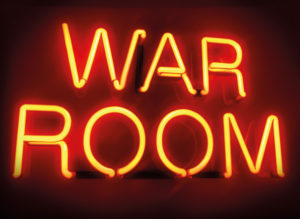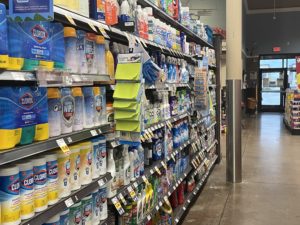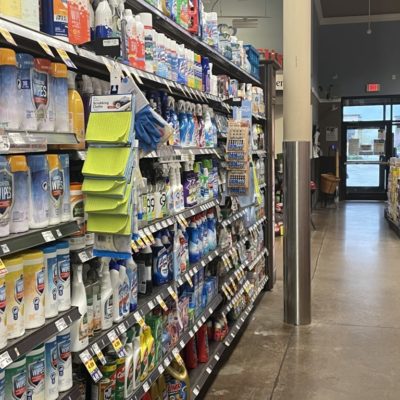| Every two years, on the first Tuesday of November, Americans gather around their TVs and radios. They stare at their laptops, tablets, and phones, transfixed by a singular process inherent to all democracies. Every two years, Americans vote in national elections.
Voting is the most sacred process of any democratic society. Dating to Ancient Greece, where every male citizen was obliged to cast his vote on questions ranging from the distribution of wine to declaring war on enemy states, the vote is the basic building block of democracy.

But, in our modern, capitalistic society, not all votes are cast at the ballot box. Many of our collective choices are measured by the purchases we make. The process by which we cast our votes for one product over another is the building block of retail. The results of these votes may not determine who lives in the White House or the direction of foreign policy, but they impact our economy and our lives as consumers.
When a shopper casually chooses to place one item in her basket and not another, that choice can spell success for a product line, a brand, or a manufacturer and failure for others. When a shopper selects one item from among the 40,000 items on the 40,000 square feet of shelves in an average supermarket, he is casting a vote for that item above all other items in the store. The more votes an item receives from shoppers, the more worthy it is of its place on the shelf.
Brands and manufacturers spend millions of dollars each year trying to understand why shoppers choose certain items over others. The complexity of this task becomes apparent once we understand that in most cases the shoppers themselves do not know why they select a specific item. Their motivations lie deep beneath their conscious minds.
Habit drives most of our shopping purchases. Let’s look at the example of a shopper who wants to purchase a bottle of ketchup. Like countless shopping trips before, she has stopped at her regular grocery store on the way home from work to pick up a few items for that night’s dinner.
She enters the aisle where she knows she can find ketchup. But she is not thinking about ketchup. Perhaps she is thinking about an important project at work, a trip she plans to take this weekend, a bathroom faucet that needs repairing, or perhaps she is on the phone with a friend.
As her conscious mind is occupied by any number of things far more engaging than ketchup, her eye is met with a wall of red. Hundreds of bottles of ketchup, half a dozen brands, different sizes, different flavors, sugar free, organic, low sodium, and even “catsup” all vie for the shopper’s attention. But our shopper is not interested in 99% of the items screaming at her from the shelf.
Our shopper does not need to consider her decision. She knows which bottle of ketchup she wants. She knew which bottle she would purchase before she even entered the store. She will buy the same brand of ketchup she has bought dozens of times before. Her choices and actions on this shopping trip are driven by the habits formed over a lifetime of shopping trips. Her only objective now is to find that one bottle among the hundreds on the shelf.
As our shopper’s eye scans the shelf, her subconscious mind receives a cue that alerts her to the specific bottle of ketchup she wants. Perhaps it was the size and shape of the bottle, perhaps it was the typeface on the label, or a particular logo or design, something prompted our shopper to pick up this specific bottle of ketchup and place it in her basket without ever consciously thinking about it.
And, just like that, a vote has been cast for that specific ketchup item. Every day, in every aisle of every store, shoppers are casting votes for thousands of items in much the same way. They rarely ponder or consider their votes beyond the simple declarative: “This is the one I want”. They move through the aisles, their conscious minds occupied by forces often outside of the supermarket, and they react to subconscious cues, triggers, which alert them to the few specific items they seek among the thousands on the shelves.
Often, shoppers cannot tell you what triggers their purchase of a specific item. But for brands and manufacturers, understanding a product’s trigger and its connection with shoppers is key to success.
In January of 2009, the number one orange juice brand in North America, Tropicana, launched a new package design. PepsiCo, Tropicana’s parent company, had spent $35 million on the new packaging and accompanying advertising campaign. According to the advertising agency that developed the campaign, the goal of the redesign was to modernize Tropicana’s image. 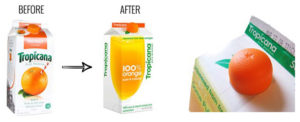
The agency drastically changed Tropicana’s packaging. They changed the typeface, replaced the tagline, “Pure Premium” with “100% Orange”, and, most egregiously, removed the iconic orange with a straw sticking out of it and replaced it with a generic glass of orange juice.
The orange was now the cap, which was shaped to look like half an orange sitting atop the carton. This complimented the ad campaign which featured the slogan, “Squeeze, it’s a natural”. Customers “squeezed” the orange as they removed the cap.
Clever. Very clever.
Tropicana’s sales dropped by 20% in the first month after the debut of the new packaging. PepsiCo immediately reversed the changes, but not before losing more than $50 million on the whole debacle.
In part of his statement on his company’s reversal, Neil Campbell, president at Tropicana North America, said: “We underestimated the deep emotional bond they (the customers) had with the original packaging… That wasn’t something that came out in the research…”
PepsiCo had spent millions on researching the changes to Tropicana’s packaging before they launched the new design and campaign. They had, presumably, asked shoppers their opinions about the changes and shoppers had, presumably, responded favorably. In focus groups or in-store interviews, shoppers could not have told PepsiCo they did not like the changes to Tropicana’s packaging because the changes did not impact them on a conscious level.
While bland, there is nothing outwardly offensive about the redesigned package. It tells the shopper, who is consciously observing the package, everything she wants to know. It’s Tropicana orange juice.
It was not until shoppers faced a wall of orange juice choices and their subconscious minds could not find the trigger that alerted them to the specific carton of orange juice they sought that they realized the failures of the new packaging.
No matter what questions PepsiCo asked, shoppers could never have communicated the subconscious importance of the iconic straw sticking out of the orange, or the typeface of the Tropicana name, or the tag line: “Pure Premium”. It was not until they had been removed that both shoppers and PepsiCo realized their value as auto-triggers, beacons among the dozens of competing orange juice brands on the shelves, alerting shoppers; “Here I am! I am the one you are looking for!”
If shoppers cannot tell brands and manufacturers what subconscious cues alert them to specific items on the shelves, how can brands and manufacturers know what the valuable triggers of their products are?
The only way to understand what triggers a shopper to choose one item over another is through observation. By witnessing the moment a shopper decides to cast her vote for a specific product and seeing exactly what the shopper’s eye sees immediately before she selects an item, a brand can determine the trigger, or triggers, that initiated that subconscious action. By observing what the shopper observed, a brand can identify its most valuable auto-triggers.
The most accurate way to measure what the shopper sees is through point-of-focus, eye-tracking headwear. In these studies, a shopper agrees to wear a pair of eye-tracking glasses that measure and record the shopper’s eye movements as they shop. Researchers then analyze the data recorded by the eye tracker to determine what the shopper looked at and what they focused on as they selected items from the shelves.
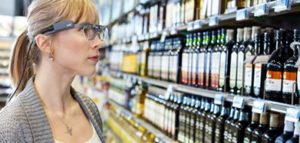
Researchers have used wearable eye tracking technology to study shopper eye movement and focus.
No brand, manufacturer, ad agency, or market research company has the resources or ability to outfit millions of shoppers across the country with eye-tracking glasses. As shoppers cast their votes, endorsing one item out of thousands, millions of times a day, how can we count these votes? More importantly, how can we understand what motivates each vote?
Existing, patented technology developed to observe the shopper from the shelves and record the moment of choice could revolutionize our understanding of shopper behavior. Dual camera technology designed to record the actions of shoppers in the aisle in relation to specific items on the shelves can deliver the power of millions of observations per day to the brands and manufacturers.
While less accurate than eye tracking glasses worn by shoppers, this shelf-based technology can deliver a reasonably close approximation of a shopper’s eye movement and focus, enabling brands and manufacturers to identify the triggers that initiate the purchase of their specific items.
This technology has not been developed in a vacuum. Cashierless stores, mobile and cloud technology are converging to provide brands, manufacturers, and retailers with an unprecedented understanding of their shoppers. Connecting these systems and combining the data they harness with insightful analysis could empower brands and manufacturers with the kind of personal selling techniques that have been lost to retail for more than a century.
Making every vote cast by every shopper count, in every aisle, in every store, every day will enable brands, manufacturers, and retailers to sell more.
Here’s to GREAT “Shopping” for YOU!!!
Your friends, Ray and Herb Sorensen |


